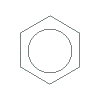Addition Polymerization
Addition polymers form:
- when unsaturated carbon (organic) molecules react to form a long chain polymer molecule
- and no small molecules or atoms are eliminated during the reaction
The general reaction can be represented as:
| nR-C=C-R' | catalyst → | -(- | R | C | - | R' | C | -)n- |
where R and R' can represent hydrogen atoms, halogen atoms, alkyl or other carbon-containing side chains.
| Monomer Name Monomer Structure | Polymer Name Polymer Structure | Polymer Uses | |||
|---|---|---|---|---|---|
| ethene (ethylene) CH2=CH2 | polyethene (polythene or polyethylene) -[-CH2-CH2-]n- | LDPE for sandwich wrap, cling wrap HDPE for water pipes, wire insulation | |||
| propene (propylene) CH2=CHCH3 | polypropene (polypropylene) -[-CH2-CHCH3-]n- | electrical appliances, automotive applications, ropes, carpets, films | |||
| chloroethane (vinyl chloride) CH2=CHCl | polyvinyl chloride (PVC) -[-CH2-CHCl-]n- | indoor electrical conduit, underground water pipes | |||
| tetrafluoroethene (tetrafluoroethylene) CF2=CF2 | polytetrafluorethene (polytetrafluoroethylene, teflon) -[-CF2-CF2-]n- | Insulation for wires, motors, generators, etc. Anti-stick applications in cookware, bearings. | |||
| styrene (vinyl benzene) CH2=CH  | polystyrene
| heat and electrical insulation, pipes | |||
| acrylonitrile (vinyl cyanide) CH2=CH-CN | polyacrylonitrile -[-CH2-CHCN-]n- | acrylic fabrics stronger than wool | |||
| vinyl acetate CH3COOCH=CH2 | polyvinylacetate (PVA) -[-CH3COOCH-CH2-]n- | adhesives, paints | |||
Condensation Polymerization
Condensation polymers form:
- when bifunctional monomers react to form a long chain polymer molecule
- small molecules, such as water, are eliminated during the reaction
Polyesters, polyamides, proteins and polysaccharides such as cellulose, are all examples of condensation polymers.
Polyesters
Polyesters form when the -OH functional group of one monomer reacts with the -COOH functional group of another monomer.
An ester link (-COO-) is formed between monomers during the reaction.
H2O is eliminated in the reaction.
General reaction between a dicarboxylic acid and a diol:
| HO | C || O | - R - | OH | C || O | + | HO- R'-OH | → | OH | C || O | -R- | C || O | -O-R'-OH | + | H2O |
Example:
terephthalic acid + ethylene glycol → polyethyleneterephthalate (terylene or dacron)
nHOOC COOH + nHO-(CH2)2-OH → -(-OC
COOH + nHO-(CH2)2-OH → -(-OC COO-(CH2)2-O-)n- + nH2O
COO-(CH2)2-O-)n- + nH2O
 COOH + nHO-(CH2)2-OH → -(-OC
COOH + nHO-(CH2)2-OH → -(-OC COO-(CH2)2-O-)n- + nH2O
COO-(CH2)2-O-)n- + nH2OPolyamides
Polyamides form when when the -COOH functional group of one monomer reacts with the -NH2functional group of another monomer.
An amide link or peptide bond (-CO-NH-) forms between monomers during the reaction.
H2O is eliminated in the reaction.
Proteins are naturally occurring polyamides.
General reaction between a dicarboxylic acid and a diamine:
Example:
hexanedioc acid + 1,6-hexanediamine → nylon-6,6 + water
nHOOC-(CH2)4-COOH + nH2N-(CH2)6-NH2 → -(-OC-(CH2)4-CONH-(CH2)6-NH-)n- + nH2O

ليست هناك تعليقات:
إرسال تعليق